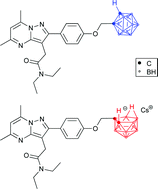Synthesis and cellular uptake of boron-rich pyrazolopyrimidines: exploitation of the translocator protein for the efficient delivery of boron into human glioma cells†
Abstract
New 1,2-closo- and 7,8-nido-carboranylpyrazolopyrimidines bind to the translocator


 Please wait while we load your content...
Please wait while we load your content...